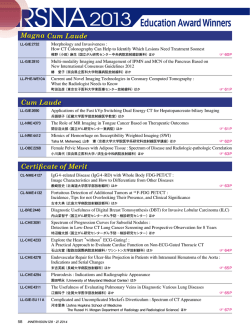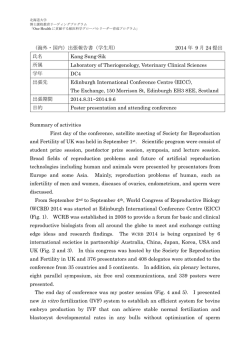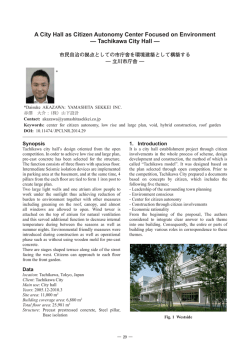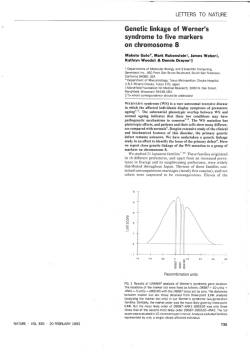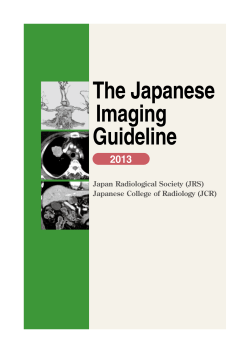
TECHNーCAL N。TE
Magn Reson Med Sci,Vol.6,No.2,pp. 113-120,2007 TECHNICAL NOTE Optilnized System Design and Comstructiom of a(Compact Whole‐ hand Scammer for lDiagnosis of]Rheumatoid Arthritis Shinya】 車ANDAl*,IIiroshi YosHIoKA2,sadanori ToMIHAl,TOmoyuki HAISH13, and Katsulni KosEl l動Mブ物 ″ cり rン 夕た冴みα 勾物 ″2が Phys,cs,t/ziソ c容,ゥ こ ア 盈予 7-F― F 7珍 ″″θdαら7む冴た冴うら rう α物を,Jθ5-8j7,,ブ ,pα″ 2D年,α iθ r″ r,gttα ″cttrザ択α所?′ θ tt α 湾 ″ 初夕 れ な角 rο 』 α ο Srο れ,Massac乃倣F冴生 し,M ダ gノ,β wル ら 3舟互R ttc乃 刀0′ο =れc。 , 殆 夕そ夕うo,力 pα″ gノ (Rcceived January 29,2007;Accepted NItarch 28,2007) We have developed a compact magnetic resonance(MIR)imaging scanner with perma― nent lnagnet,gradient coil set,and radiofrequency(RF)collS Optilnized for whole―hand examination for the diagnosis of rheumatoid arthritis(RA).The System weighs about 2,eXCluding the shiё 600 kg,and installation space is 2 1■ ld room.Hand exa■ linations of normal volunteers and patients、 vith RA、vere performed using a 3D Tl― 、 veighted gradient― echo(GRE)sequence and short TIinversion recovery 3D fast spin"echo(STIR-3DFSE)se― quence, and anatonlical structures and various lesions of the hand caused by RA、 vere clearly visualized in a 16-lnin exanlination,It was concluded that the systen■ could be used for diagnosis of RA in even a small clinic. Keywords:プ ソ Rち ぎ 鶴ate4″ coあ Per碗 ″Z夕 ″す初 agz夕 ち RF cο Introduction WIagnetic resonance(NIR)iIIlaging of the hand is 、 videly accepted as a very useful tool for diagnosing rheumatoid arthritis(RA)。 13 HoweVer,examina― tion using conventional、 vhole―body WttR imaging scanners is painful for patients because they must place their hand(S)in the center of the magnets. One of the best solutions to this problem is the use of a syste■l specially designed for imaging human extremities, For this reason and for economy, several such commercially available WIR imaging systems have been used for hand exanlinations to diagnose RA.4 Such systems are adequate for diagnosis and more comfortable and convenient for the patient.Early detection of RA is essential for drug therapy and requires whole― hand exalnination because the locations of lesions caused by RA in the hand cannot be predicted.The usefulness of colnlnercial― ly available WIR systems for imaging the extremities is seriously limited because their ields of vie、 v tt SER,ガ ル ″物 ″すο,冴 α/れ rtをts quires the development of anヽ 在R systenl for imag― ing extrelnities that has a suttciently large FOV for 、 vhole―hand exanlination. We have already reported and demonstrated the ical ettcacy of an WIR scanner with a relatively cli■ large FOV(abOut 20 cm X 20 cm)fOr wh01e― hand examinations,5,6 However,installation space(abOut 61n2)and tOtal weight(about 1500 kg)Of the sys― teln are too large for its use in a small clinic. In this study, we have developed a compact 、 vhole中hand MIR imaging scanner that requires only a 2rn2 for installation, weighs about 600 kg, ex― cluding the shield rooln,and can be used in even a small clinic. Compact Whole‐ hand Scanner Figure l sho、vs an overview of the compact 、 vhole― hand scanner we developed. It consists of a permanent magnet(NEOMAX Co., Osaka, Japan), gradient coil set, radiofrequency (RF) OrObe,and portable WIR imaging console.7 Th (FOV)are tOO Small to assess the hand and wrist magnet was placed in an RF shield room (1.4m in one exanlination. Overcolling this problenl re― wide× 2 m high× 2 m deep)to preVent external RF noise.The installation space for the entire system ネ Corresponding author,Phonc: +81-29-853-5214,Fax: +81- 29-853-5205,E― mail:[email protected] measured l■ 1× 2 1n excluding the shield rooHl and 2111× 2 1n including the shield room. 114 S.Handa ct al Figure 2A sho、 vs the permanent magnet: fleld turns for the transverse coil and 30 turns for the strength,0.21T at 24.5° C;gap,16 cHl;homogenei― 20 cHl× 12 cn■ di― ty, 34.6 ppln over the 20 cnl× ameter ellipsoidal volume(DEV); and Weight, 520 kg. The size of the homogeneous region、 vas vhole hand of an adult deterIIlined to include the、 B一Fe mag― person. Because this magnet used Nd一 netic lnaterial,the temperature dependence of the axial coil. Grooves(1.l mm wide,2.2 mm deep)for the gradient coil、vinding pattern、 vere lnilled on Bake― lite plates 2.7 1nm thick by a numerically controlled lnilling machine according to the numerical data calculated for the gradient coil set. Polyethylene― coated copper wire(1-mm diameter)Was used for m a g n c t i c i e l d s t r e n g t h w a s a b o u t -C1.1 0 0thep coil、vinding.The pm/° To lninilnize the temperature drift of the magnetic 3-axis gradient coil assembly VaS Inadc by piling the(3y and Gz coils on theく ヽ neld, a temperature controller、 colls.The DC resistance and self― vith proportional― integral―derivative(PID)contr01lers was used. Figure 2B and C sho、 vs the planar gradient coils; gradient coils are tabulated in Table l, Two RF probes were developed for this system. thc transverse(x and y)gradient coll、 vas designed using thc target― fleld approach,8 and the axial(z) A 14-turn solenoid (oVal aperture 6 cnl wide× 12 cm high and 22 cm long)was uSed for whole― gradient coil,a genetic algorithm(GA),9 HoWever, in both design lnethods,efFects from the pole pieces hand ilnaging(Fig. 3A). An eight― turn solenoid 、 vere not considered.10 The design parameters、vere: magnet gap, 16 cln; target― Ileld regio■, 20 cIIl× 20 cIIl×12cm DEV;diameter of the current flo、 v― ing region,36 cln;and number ofturns of、 vires,24 Fig.1. Overvie、v ofthe compact、 vhole‐ hand scan― ner installed in our university hospital. 3x inductance of the Fig.3。 (A)Radiofrequency(RF)probC fOr a whole hand.(B)LC circuit of(A).(C)RF probe for high‐ resolution wrist imaging.(D)LC circuit of(C). Fig。2. (A)Perl■ anent l■agnet.(B)TranSVersc(x and y)gradient coll.(C) Axial(Z)gradiCnt coil.The diameter of the gradient coils is 38 cm. 障Iagnetic Resonancc in Mcdical Scicnces Compact WVhole Hand Scanneコ Table l. 115 DC rcsistancc and sclf― 275 inductance of thc gradicnt colls lnductancc(μ H) Resistance(0) 3 1 5 6 4 5 8 8 8 x z GQG 1.45 1.44 1.28 ‐ ︵ゆ聖 OΦじ aE oロ Gradicnt coil -a wthouttemp cOntrol b Mlhtemp ccnlrol ― 才 / (OVal aperture 7 cm wide× 9cm high and 7cm iOng)Was used for high― resolution wrist imaging j m 。( m i n ) Fig.4. Larmor frcqucncy drift of thc pcrmanent (Fig.3C).Both SOlenoids were stored in RF shield magnct measured whcn thc temperaturc controller boxes for electrical stability.The LC circuits for the RF probes are shown in Fig。 3B and D. ExperiIIlents 、 vas on and ofF and、 vhilc a 3正 )gradicnt ccho imaging sequcncc was running.Thc Larmor frcqucncy f(T) 、 vas plotted as a temperature T° C according to thc equation f(T)=8.9174{1-0.0011(T-24.5)}. NIeasurements of system performance The temporal stability of the magnetic lleld of the permanent magnet 、 vas measured using the Larmor frequency of a water phantonl、 vhen the temperature controller of the rnagnet、 vasturned on and ofF.The Larmor frequency lneasurements、 vere performed using an internal NWIR lock technique previously described.7 The magnetic neld generated with the gradient coilset was measured both in a free space and in the magnet gap space. In the free space,the gradient their hands into the RF coil for W【 R exallinations. WIR exa■ linations for the norimal volunteers were IR exaIIlinations of performed on the left hand. い ブ vere perforined on both hands. patients、 Corona1 3D gradient― echo Tl― weighted ilnages (repetitiOn time[TR]=50 ms,echo time[TE]= 9 Hls,nip angle[FA]=60° ,and number of excita― tions[NEX]=2)were aCquired with an image matrix of 512× 256× 16 and FOV of 20。 48c11× 20。48c1lX6。 4cm. Thus, the total scan tilne 、 vas coil assembly 、 vas constructed using alulninum about 7 111in.Coronal short TI(inverSiOn tilne)in― column spacers(15-mm diameter),and the magnet― version recovery with 3D fast spin echo(STIR― ic ield、vas measured using a Hall magnetometer 3DFSE)imageS Were acquired with an image matrix (F.W.Bel1 6010,USA)when a COnstant current of 256× 256× 8 in the same FOV. The scan pa― ralmeters of the STIR-3DFSE sequence were:TR =1000 1ns,TI=100■ ls,and efFective TE(TEer)= (10A)was supplied to the gradient coils. In the magnet gap space,the gradient coil set、 vas nxed on the lnagnet pole pieces,and the lnagnetic fleld was measured with att NMR Teslameter(MetrOlab 40 HIs,echo train length(ETL)=8,and NEX=2. Thus,the total scan tilne was about 8.5 1nin.The lnstruments, SA, Switzerland)when a cOnstant TI、vas deterlnined for the fat signal so that it could current(2A)was supplied. be lninlmlzed. Another 、 vater phantoHl 、 vas used to measure linearity of the magnetic neld gradients and homogeneity of the radiofrequency neld of the RF coil for a hand. The phantom consisted of 32 acrylic cubic containers(lengths of the external and internal edges: 2.4cm and 2.Oc■ 1, respectively) stacked in an 8 X 4 array,ealh container I11led、 vith aqueous CuS04 SOlution. Imaging experilllents The WttR imaging systeIIl 、 vas approved by the ethics conllnittee Of Our university hospital to be used for clinical tests in our hospitale Subjects、 vere ll healthy volunteers and 33 patients、 vith either ``suspected early RA,ル ``early RA,''or``advanced High―resolution 3D GRE images of the wrist were obtained with a smaller FOV using 3D gra― dient echo sequences(TR=50m■ FA=60° ,and NEX=2 or 8). s,TE=8 or 91ns, Results and Discussion WIcasurements of system performance Figure 4 shows the Larmor frequency of the magnet measured for about 8 hours when a 3D GRE imaging sequence(TR=50 ms,TE=9 ms) was running.The Larmor frequencyし ″り MHz Was C)assuming the plotted against telmperature r(° =8.ク77イ following equation: ヮ /rう θFFrr一 {F一θ.θ RA.ル After giving informed consent,the subjects 2イ.り〉 .This equation was based on a Larmor fre― sat on a chair in front of the lnagnet and inserted Hz at 24.5° C measured in the quency of 8.9174W圧 Vol.6 No.2,2007 S.Handa et al. Z imml Z imml A B Fig。 5. (A)MagnetiC Ileld Bz produced by thc transvcrse gradicnt coil(x ory)CalCulatcd for thc xz planc(y==0)in a frCC Spacc.(B)MagnCtiC neld Bz produccd by the transvcrsc gradient coll(x ory) measured for the xz plane(y==0)in the lnagnct gap space.Thc contour lines are dra、 vn by thc O.1 Gauss step. Fig.6. (A)MagnetiC neld Bz produced by thc axial gradient coll calculated for the xz plane(y==0) in a free space.(B)MagnetiC Fleld Bz produced by the axial gradient colllncasurcd for the xz plane vn by the O.l Gauss stcp. The largc (y==0)in the magnct gap space. The contour lines are dra、 inhomogcneity seen at around z=30 1nnl and x=-100 111m in B is froln a lneasurcmcnt error but docs not afFect our cxpcrilncntal results. N E O N t t A X f a c t o r y a n d t h e a s s u m p t i o n t h a t t h e (B)magnetic Flelds in the xz plane(y=0)prOduced temperature coettcient of tho lnagnetic nux density by the Gx gradient coil;the lneasured gradient ield of the permanent magnet material 、 vas -1100 、 vas larger than that calculated because the rnagnet― C . ic fleld、 vas enhanced by the lnagnetic materials of ppm/° As sho、vn in Fig.4,、 vhen the temperature con― troller of the inagnet、 vas not used,the drift of the Larmor frequency was about 2 kHz/hour,which the permanent IIlagnet. Figure 6 shows the calculated(A)and measured may be attributable to both the Joule heat pro― (]B)Inagnetic llelds in the xz plane(y==0)prOduced by the Gz gradient coil;the lneasured gradient fleld duced by thc gradient coil set and change in room 、 vas larger than that calculated because the lnagnet― temperature.IIo、 vever,by setting the magnet tem― ic lleld、 vas enhanced by the magnetic materials of perature several degrees higher than room temper― ature, the temperature drift、 vas stabilized、vithin about O。 1°C for 8 hours, suttcient for the 7-and the permanent magnet. The magnetic lleld 、 found to distort near the edges of the pole pieces, 8.5-Inin hand exanlinations. Figure 5 shows the calculated(A)and measured vas 、 vhere the Rose shinl、 vas attached. Table 2 summarizes the emciency of the gradient colls obtained froln the numerical calculation and MIagnctic Resonancc in Mcdical Sciences ︲ ︲ Compact Wholc Hand Scanncr ン ヽ Table 2. Efnciency Of the gradicnt colls obtaincd from numcrical calculation and expcrilncnts 熙 血 a∝ Ma謡 ap ゴ 熙 calCulation Frec帥 熙 Gr齢 ン 0。 126(1.83) 0。 130(1.97) 0.276(1.54) B 0.069 0.066 0.179 ヽ G G G 0.0720(1.04) 0.0708(1.07) 0.1790(1.00) Ettciencics of the gradient coils(G/cm/A).ValuCS in parentheses are normalizcd using values from measure― mcnts in free space. the lneasurements described above.The calculated ettciencies、 vere in good agreement、 vith the values IIleasured in free space. IIo、 vever, the measured ettcicncies in the lnagnet gap space、 vere l.5to 2.0 tilnes larger than those in free space. The enhancement rates、 vere roughly explained by the lnirror― current theory for the pole pieces.11 However, the enhancement rate of the Gz 、 vas deinitely smaller than those of the Gx and Gy・ These data suggest that the eIFect of the magnet yoke must be considered for the Gz coll because the magnetic nux generated by one piece of the Gz coil tries to decrease that generated by the other piece of the Gz coll set through the yoke.1° Figure 7 sho、 vs cross―sectionalilnages of the cube array phantom acquired with 3D spin― echo se― quences(TR=100 ms,TE=16 ms,image matrix= 512× 256× 64, FOV=20。 48 cnl× 10。24 cln X 5.12 cm,and voxel size=0。 4mm× 0。 4mm× 0.8mm)。 The、 vater phantom was imaged、 vith positive and negative readout gradients to lneasure the erects of static magnetic neld inhomogeneity on image dis― F Fig.7. Cross― sectional planes of the watcr phan― tom acquired with 3D spin echo scquences.A(xy planc),B (xZ plane),and C (yz planc)、 vcre acquircd 、 vith the sequencc、 vith a positivc rcadout gradicnt along the x direction,transverse dircction in A.D(xy planc),】E(XZ planc),and F(yz planc)、 Vere acquircd 、 vith thc scquence with a negative rcadout gradicnt along the x dircction. tortion. The most remarkable image distortion observed in Fig.7 is caused by nonlinearity of the lnagnetic that there is no problem in clinical applications. lleld gradients. As sho、 vn by the cube size in the WIR ilnages,the gradient neld strengths at the right Figure 7A,C,E),and F demonstrates an increase in image intensity froln the left to the right caused and left edges ofthe phantom in Fig.7A,C,E),and F are about 700/。 of those at the center of the gradients. Ho、 vever, because the spatial variation by a tuning circuit property of thl RF probe, wherein the Q factOr Ofthe RF probeis around 300 of the image distortion is small,the image distor― Because we used the long solenoidal RF coil,there tion can be easily corrected and、 vill have no prob― le■l in clinical applications. The eniects of static rnagnetic fleld inhomogeneity a n d t h e t u n i n g f r e q u e n c y r a n g e i s s m3 a0 l lk (H ∼ z). 、 vas no other detectable RF neld inhomogeneity in the phantoln experilnents. Imaging experilnents on image distortion can be evaluated by comparing the size of the cllbes acquired 、 vith positive and negative readout Fleld gradients.Because the cubes Figure 8 sho、vs coronal cross―seCtiOnal ilnages of the left hand of a normal volunteer acquired、 vith at the right edge(Fig. 7A)and left edge of the Although ghost artifacts caused by lnapping of the phantom in(Fig.7E))are identical,the size direr_ ences betwcen theln along the x direction(readOut multiple spin echoes to the k― direction)represent inhomogeneity of the static magnetic fleld.IIo、 vever,the difFerence is so small 、 vere obtained. Vol.6 No.2,2007 Tl― weighted 3D GRE and STIR-3DFSE sequences. space、 vere seen in Fig.8B,12 sTIR ilnages with good fat suppression Figure 9 sho、 vs high―resolution 2D ilnages select― S.Handa et al. Fig.8。 Corona1 2D ilnages selected froln a 3D dataset of a hand of a hcalthy voluntccr.Images are acquired、vith(A)a31)gradicnt ccho scquence(repetition time tTR]=50 nls,echo time[TEl=9 ms,and FA=60° )and(B)a STIR-3DFSE sequence(TR=1000 mls,inverslon timc[TI]=100 nlS,CfFective TE[TEcr]=40 ms,and ccho train length[ETL]=8).Thc ghOSt artifacts sccn in the short invcr― sion time recovery(STIR)imageS are from altcrnativc mapping of thc multiplc spin echoes in the k― space. Fig.9. High― resolution Tl― weightcd 2D ilnages selected fron1 3D datascts of a hcalthy voluntccr.(A)Axia1 2D imagc of the distal radius.(B)COrOna1 2D imagc of thc wrist. ed from 3D image datasets acquired with 3D GRE sequences(TR=50 ms,TE=8 ms,FA=60° NEX=8 for Fig。 9A; TR=50 ms, TE=9n■ FA=60° , and NEX=2 for Fig. 9B; acquisition ,and s, time=14 min).VOXCl size was O。 25× 0。5× 2 mm in Fig,9A and O,35× 0.35× 21nm in Fig。 9B. All ll healthy volunteers and 32 of the 33 Figure 10 sho、 vs corOnalilnages of both hands of a patient with suspected early RA.These 2D ilnages are selected from a 31)image dataset acquired by STIR-3DFSE sequence.In Fig。 10,multiple areas of high signal intensity、 vere seen along the nexor and extensor tendons and at the metacarpal and intercarpaljoints.These high signalintensities wer vent successfulトッ IR exalninations of patients under、 v o of the patients、 vith both hands and、 vrists. T、 consistent、vith lesions caused by early RA. suspected early RA(n=10)Were diagnosed with hand and more than 301nin for both hands. Although this may appear long for the patients, early RA based on STIR images.All patients with early and advanced RA sho、 ved morphological or signal intensity changes that enabled diagnosis of RA froHI NItR imaging indings. Measurement required about 161nin for one fe、 v complaints 、vere raised because the patients 、 vere in relaxed positions. IIo、 vever, much higher noise ratios(SNR)or ettCient pulse se― s i g n a lt― o― 障Iagnctic Rcsonancc in A/1edical Scienccs Compact Whole Hand Scanner Fig.10。 Corona1 2E)images selccted from 3D datasets Of both hands of a patient with suspected carly rhcumatOid arthritis(RA)acquired with thc shOrt TI CnVCrSiOn tinle)inversion recovery with 3D fast spin echo(STIR-3DFSE)sc― quencc(repetition time[TR]=1000 ms,cchO timc invcrsion time[TI]=100 ms, cfFectivc ccho tilne[TEcr]40 1ns,echo train lcngth[ETL]=8,matrix size=256× 256× 8,and voxel sizc=0.8mmXO.8mm× 8mm).SynOvitis and tcnosynovitis are identilled in lnultiplc regions(arrOヽ VS). quences are needed to ilnprove patient through― put.The straightfor、 vard solution to establishing a higher SNR is to use a higher IIlagnetic lleld.If we use a narro、ver Fnagnet gap and optilnized gradient sets for the narro、v gap,、ve may construct a com― pact hand scanner 、 vith a much higher magnetic ield(abOut O.3T). References l. Klarlund N4t,Ostcrgaard M)Jcnsen KE,Madscn 」L, Skjodt ]H, Lorenzcn I. M【 agnctic rcsOnance ilnaging, radiOgraphy, and scintigraphy of the flnger joints:One ycar vf0110、 up of patients、 vith 2. Condusion We developed a colnpact MIR imaging systeln for diagnosing rheumatoid arthritis in the hand, including the wrist, by optilnizing the permanent magnet, gradient coil set, RF coils, and pulse sequences. The systeIIl weighs about 600 kg, and installation space is about 2 1n2, eXCluding the shield room.Because WIR exa■ linations of patients 、 vith RA suggested the clinical ettcacy of this sys― tenl,we concluded that our system■could be used to diagnose RA in even a small clinil. Ackmowledgements We lhank PrOfessor Takayuki Sunlida and Dr. Satoshi ltoh fOr perlnitting us to use NItR images Of a patient, MIro Natassaki Aoki and MIr. Eiichi Sugiyalma of NEOWIAX Co.for constructing the permanent magnet used for this study, and Drs. Shin Utsuzawa and Andre、 vいッ IcDo、vell for develop― ing the image acquisition software. early arthritis.The TIRA Group.Ann Rhcum Dis 2000;59:521-528. Sugilnoto H,Takcda A,Masuyama J,Furuse M. Early―stage rhcllmatoid arthritis: diagnostic ac― curacy of¥R imaging.Radiology 1996;198:1853. 4. 192. Sugilnoto H, Takeda A, Hyodoh K. Early,stage rheumatoid arthritist prospective study Of thc cttcctivencss of MR ilnaging for diagnosis.Radiol― ogy 2000;216:569-575. Evaluation of 10、 v_fleld cxtrelnity magnetic resO_ nance imaging(MRI),Amcrican Collcgc of Rhcu― matology,2005. 5. Kurimoto T,Furuya T,Tomiha S,et alo Colnpact Hand MRI Systcms using Pcrmancnt Magnets,In: Proccedings of the 12th Annual NIeeting of the ISMRM)Kyoto,2004;1638. 6. Yoshioka II, ItO s, Handa S, ct al. Lo、 v― ield compact magnctic rcsOnancc imaging system for the hand and、 vrist in rhcumatoid arthritis.J Nfragn Reson lmag 2006;23:370-376. 7. Haishi T, Uematsu T, Matsuda Y, Kosc K. Devclopmcnt of a l.O T NIR nlicroscopc using a Nd― Fe―B pcrmanent magnct. N【 agn Rcson lmag 2001; 19:875-880. 8. Turncr RA.Targct ield approach to optilnal coil dcsign.J Phys D:AppI Phys 1986; 19:147-151. 9. Goldberg DE. Genctic algorithms in search, optimization and machinc learning.First cditiOn. Vol, 6 No.2,2007 S.Handa et al. 120 10. Boston: Addison― Weslcy Longman Publishing, 1989. Handa S,Okada F,Kose K.EIFects of maglletic circuits on magnetic lleld gradicnts produced by planar gradient coils. In:Proceedings of the 13th Annual Meeting ofthe ISNIRNI,Miami,2005;851. NIoon CH,Park]HW,Lee SY.A dcsign lnethod inductance planar magnetic reso― for ■linilnuHl― nancc imaging gradient coils considering the pole― piecc eIFect. Nfteas Sci Technol 1999; 10:N136N141. 12. Keller PJ,IIciserman JE,Fram EK,Rand SD, to―view Drayer BP. A Nyquist modulatcd ccho― mapping scheme for fast spin― lcho imaging.NIagn Reson Nlted 1995,33:838-842. Magnetic Resonance in Medical Sciences
© Copyright 2025
